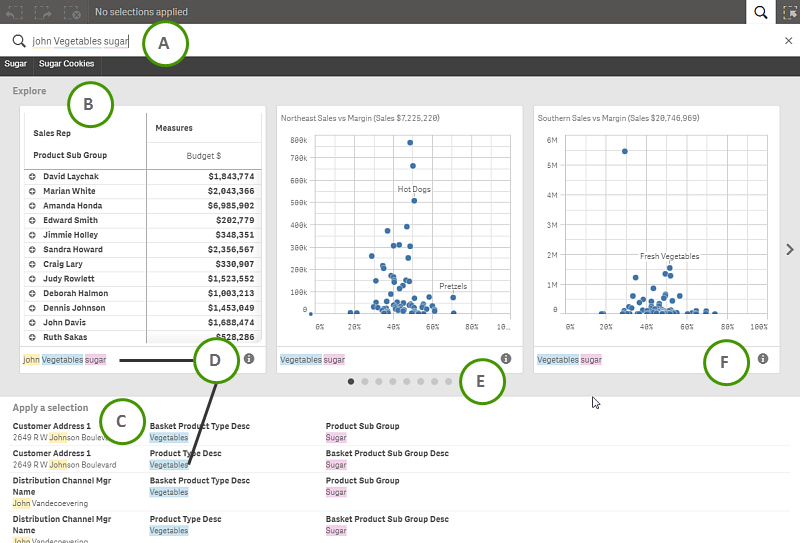Smart search is the global search tool in Qlik Sense, enabling you to search the entire data set in your app from any sheet in the app. Smart search is available from the selections bar in a sheet by clicking F.
Smart search

Smart search returns results in two ways: under Explore, where the visualizations in which the search terms are found are displayed, and under Apply a selection, where lists of matching data items are shown.
Smart search only supports text search. Search operators other than quotation marks are not supported
When you click on a result under Explore you will jump to the sheet on which that visualization appears. If you click on a result under Apply a selection, the results disappear and the selection is applied.
Smart search is available when you are analyzing data on a sheet. From the visual results you can navigate directly to the sheet on which the visualization is found. The data results help you to find associations and make selections in your data.
You can also search within selections and visualizations such as tables and filter panes. See Searching within selections or visualizations.
What happens when you search
As you type your search query, Qlik Sense searches simultaneously in visualizations and data items.
Searching in visualizations, smart search filters the values as you type and displays the visualizations where the search items match the following:
- Title, subtitle, and footnote
- Dimension definition and label
- Dimension values (searching for where a dimension uses a value and displays charts where that value is used.).
-
Measure definition and label (not value)
-
Text & image object. The text in the object is not searched.
Searching in data items, smart search filters the field values and displays the matching items. Smart search looks for:
- Field values
- Dimension values (also dimension values that are created as master items)
The screenshot shows the results of searching for john Vegetables sugar, which generates one search query for each term.

| A | Search field |
Separate search terms with spaces. To link words into one search term, use quotation marks, for example, “mountain bike”. Suggested search strings are displayed beneath the search field. |
| B | Explore |
Gallery of visualizations in which search terms are found. Use the scrolling arrows to browse the results. You can also use the page indicators (E)to jump directly to a different page of results. See: Navigating to visualizations from search for further details. |
| C | Apply a selection |
The search results from the app data, shown with one result per row. Click Show me more to see more results. See: Using search results to change selections for further details. |
| D | Color-coded search result terms | A color code is assigned to each search term found. It shows partial matches as well as full matches: |
| E | Gallery page indicators |
Indicate which page of results is currently displayed in the gallery. |
| F | Visualization results information |
Click ] to see which values in the visualization the search results were found.
|
You can clear the search field by clicking ‰ to the right in the search field. Click F to close smart search.
The search terms are always compared against the beginning of the words in the database. Searching for “read” does not present “bread” as a match, whereas “reader” and “Reading” would both be matches. The search terms are each given a color to support the identification of the matches. When there are more than six search terms, the colors are reused.

